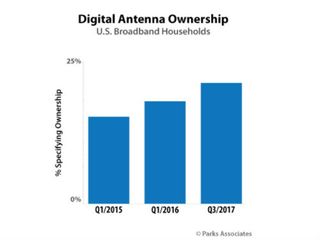Study: 20% of U.S. Broadband Homes Use Antenna for TV

In findings that highlight the growing cord-cutting trend, Parks Associates said that about 20% of U.S. broadband homes used digital, over-the-air antennas to access live TV near the end of 2017
That’s up from about 16% in early 2015, Parks Associates said, noting that the growth rate coincides with a steady decline of pay TV subscriptions against the backdrop of an increase in OTT video subscriptions.
RELATED: Top U.S. Pay TV Providers Lost 1.49M Subs in 2017: LRG
Findings from the study – 360 View: Access and Entertainment Services in U.S. Broadband Households – were based on survey of 10,000 heads-of broadband households in the U.S. in Q3 2017.
“Increasingly, consumers are cobbling together their own bundles of content sources. Digital antennas are experiencing a resurgence as consumers consider over-the-air TV and OTT video services as alternatives to pay TV,” Brett Sappington, senior director of research at Parks Associates, said in a release. “The percentage of ‘Never’ households (households that have never subscribed to pay-TV services) has held steady, and the percentage of households actually cutting the cord has increased between 2015 and 2017. Antennas are an affordable source for local channels to these households.”
In a study released earlier this week, TiVo found that about 44.8% of homes without pay TV service use an antenna to watch over-the-air TV, noting that the percentage has been hovering in the 44% to 45% range for the past six quarters.
Parks Associates, meanwhile, said the onus is on pay TV providers to address the value perception gap in the market, noting that more than 50% of homes that have switched, shaved or cut the cord believe that the service is simply not worth the cost.
Multichannel Newsletter
The smarter way to stay on top of the multichannel video marketplace. Sign up below.
“Opportunities are available. Only 46% of pay-TV subscribers are aware that they can access video-on-demand content from their operator, including free programming. Many indicate that they want to purchase online video services through their pay-TV provider and to access the service through their channel guide,” Sappington added.
Among other findings, 17% of those surveyed who canceled pay TV would have stayed if the provider did not charge monthly fees for set-top boxes, and that the average fees for standalone broadband have increased nearly 25% since 2010.
Parks Associates also said that 20% of WiFi homes experience problems with coverage, opening the door for a growing array of premium whole-home WiFi products that cable operators and other ISPs have been adding to their arsenals.
